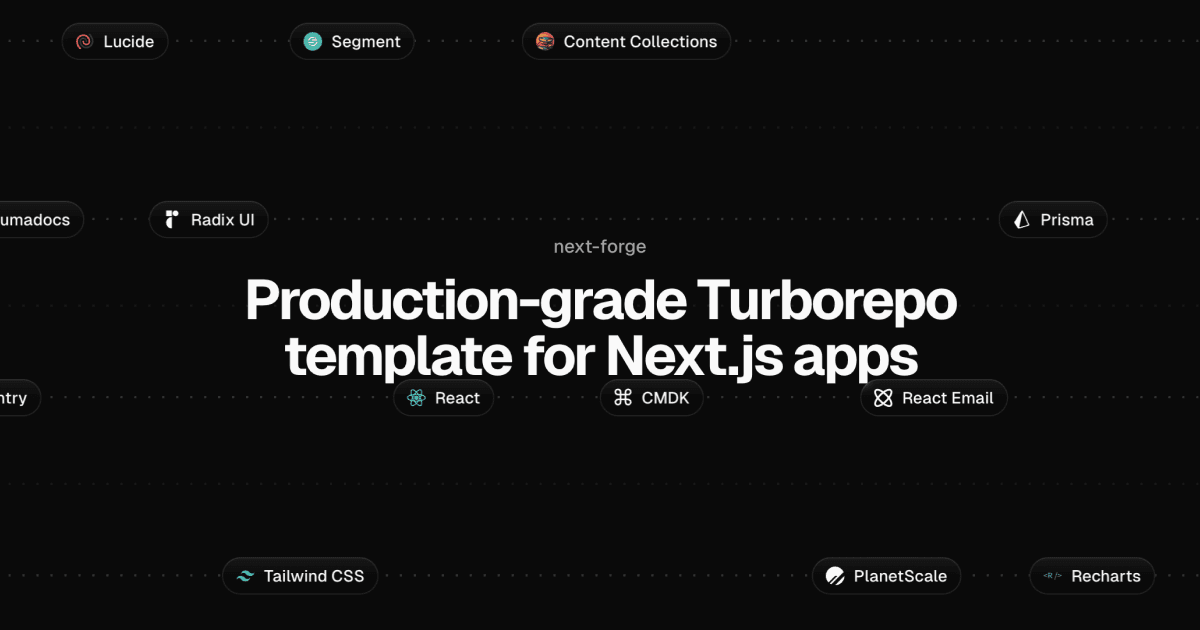
▲ / next-forge
Production-grade Turborepo template for Next.js apps.
Overview
next-forge is a production-grade Turborepo template for Next.js apps. It's designed to be a comprehensive starting point for building SaaS applications, providing a solid, opinionated foundation with minimal configuration required.
Built on a decade of experience building web applications, next-forge balances speed and quality to help you ship thoroughly-built products faster.
Philosophy
next-forge is built around five core principles:
- Fast — Quick to build, run, deploy, and iterate on
- Cheap — Free to start with services that scale with you
- Opinionated — Integrated tooling designed to work together
- Modern — Latest stable features with healthy community support
- Safe — End-to-end type safety and robust security posture
Demo
Experience next-forge in action:
Features
next-forge comes with batteries included:
Apps
- Web — Marketing site built with Tailwind CSS and TWBlocks
- App — Main application with authentication and database integration
- API — RESTful API with health checks and monitoring
- Docs — Documentation site powered by Mintlify
- Email — Email templates with React Email
- Storybook — Component development environment
Packages
- Authentication — Powered by Clerk
- Database — Type-safe ORM with migrations
- Design System — Comprehensive component library with dark mode
- Payments — Subscription management via Stripe
- Email — Transactional emails via Resend
- Analytics — Web (Google Analytics) and product (Posthog)
- Observability — Error tracking (Sentry), logging, and uptime monitoring (BetterStack)
- Security — Application security (Arcjet), rate limiting, and secure headers
- CMS — Type-safe content management for blogs and documentation
- SEO — Metadata management, sitemaps, and JSON-LD
- AI — AI integration utilities
- Webhooks — Inbound and outbound webhook handling
- Collaboration — Real-time features with avatars and live cursors
- Feature Flags — Feature flag management
- Cron — Scheduled job management
- Storage — File upload and management
- Internationalization — Multi-language support
- Notifications — In-app notification system
Getting Started
Prerequisites
- Node.js 20+
- pnpm (or npm/yarn/bun)
- Stripe CLI for local webhook testing
Installation
Create a new next-forge project:
Setup
- Configure your environment variables
- Set up required service accounts (Clerk, Stripe, Resend, etc.)
- Run the development server
For detailed setup instructions, read the documentation.
Structure
next-forge uses a monorepo structure managed by Turborepo:
Each app is self-contained and independently deployable. Packages are shared across apps for consistency and maintainability.
Documentation
Full documentation is available at next-forge.com/docs, including:
- Detailed setup guides
- Package documentation
- Migration guides for swapping providers
- Deployment instructions
- Examples and recipes
Contributing
We welcome contributions! See the contributing guide for details.
Contributors
Made with contrib.rocks.
License
MIT
Related Templates
Monorepo with Turborepo

Turborepo & Next.js Starter

Design System with Turborepo
